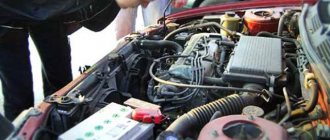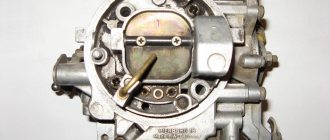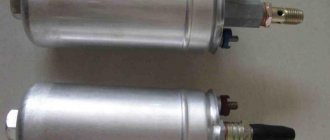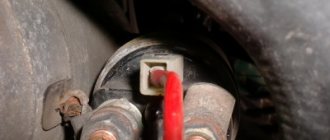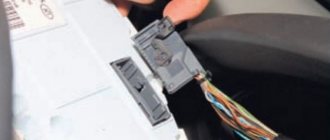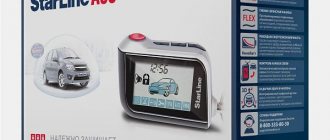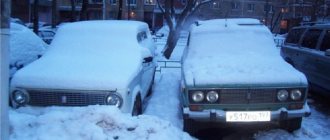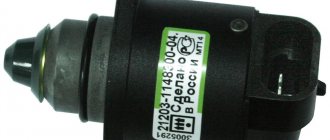If the Oka does not start, then, first of all, you should study the symptoms that appear. First of all, determine whether the starter turns. If it turns, what are its characteristics - does it work poorly, are there any sounds, and so on.
If necessary, you can try to start the car several times. If it does not turn over, then there are two reasons: a faulty starter or problems with the battery. In the first case, you need to contact a service station, and in the second, charge the battery, if possible, or change it altogether.
Some models have special protection in their design - a fuse. Finding it will not be difficult even for the most inexperienced driver. If the problem is a low battery, then the vehicle's electronics will not function fully. The most common case is terminal oxidation. To eliminate this, it is necessary to clean the terminals from dirt and oxidation elements. After this, you should carefully tighten the terminal fastening.
If there is a problem with the battery being completely discharged (for example, the headlights were on all night), it should be charged, unless we are talking about lead batteries. In the winter season, there are often frosts in many regions of our country. The car should be especially taken care of during this period. Many Oka owners take the battery home with them. Thus, being in a warm room, it will not discharge and the car will start without problems in the morning.
If the Oka does not start when cold, you should perform several actions:
- Carefully turn the ignition key to turn on electrical appliances.
- Take a break of a few seconds to allow all systems to prepare to turn on the engine. After this, you should turn the key all the way and hold it for no more than five seconds. If the Oka does not start and stalls, then you need to wait about a quarter of a minute and start the engine again.
- You can easily understand that it has started (by sounds and vibration). In the frosty season, it is recommended to turn the key to the indicator that electrical appliances are turned on and wait about a minute. Then turn on the ventilation, and then press the gas pedal about three times. The colder the engine, the longer it will take to start. The ventilation system does a great job of “waking up” the car, and pressing the gas pedal will clear the carburetor of excess gasoline.
The oil pressure light came on
If your oil pressure warning light comes on while driving, you need to stop immediately. Further driving may result in serious engine damage. After stopping, perform the following diagnostics:
— check the oil level on the dipstick;
- it is possible that oil of inappropriate viscosity has been filled in - replace it;
— remove the oil pan and check the oil receiver mesh (may be clogged) and the pressure relief valve for distortion, clogging or weakening of the spring;
- inspect the fuel pump diaphragm - if it is damaged, gasoline enters the oil, thereby diluting it;
- check the oil pump - it may be faulty due to wear on the gears;
Doesn't Start When Hot - TOP 3 Causes of Poor Engine Starting
With the arrival of hot days, more and more drivers are faced with the problem of poor engine starting when hot, after several minutes of parking. Moreover, this is a problem not only for carburetor engines - a situation where it does not start when hot can await both owners of cars with injection engines and diesel cars. Only the reasons are different for everyone. Here we will try to collect them and identify the most common ones.
When a hot carburetor engine does not start
Why is it difficult to start when hot and what to do?
the volatility of gasoline is mainly . The bottom line is that when the engine warms up to operating temperature, the carburetor also heats up, and after turning it off, within 10-15 minutes, the fuel begins to evaporate, making it difficult to start the car.
Installing a textolite spacer can help here, but it does not give 100% results.
In such a situation, pressing the gas pedal to the floor and purging the fuel system will help to start a hot engine, but not longer than 10-15 seconds, since fuel can flood the spark plugs. If the question concerns the Zhiguli, then the fuel pump may also be to blame, since Zhiguli gasoline pumps really do not like heat and sometimes completely refuse to work when overheated.
When an injection engine does not start
Since an injection engine is somewhat more complex than a carburetor engine, there will be more reasons why such an engine will not start. In particular, they may be malfunctions of the following components and mechanisms:
- Coolant temperature sensor. In hot weather, it may fail and supply incorrect information to the ECU, in particular, that the coolant temperature is higher than normal.
- Crankshaft position sensor (CPS). Its failure will lead to incorrect operation of the ECU, which in turn will not allow the engine to start.
- Mass air flow sensor (MAF). In hot weather, the sensor may not cope with the tasks assigned to it, since the temperature difference between the incoming and outgoing air masses will be insignificant. In addition, there is always the possibility of its partial or complete failure.
- Fuel injectors. Here the situation is similar with a carburetor engine. The fine fraction of gasoline evaporates at high temperatures, forming an enriched fuel mixture. Accordingly, the engine cannot start normally.
- Fuel pump. In particular, it is necessary to check the operation of its check valve.
- Idle air control (IAC).
- Fuel pressure control.
- Ignition module.
Next, let's move on to considering the possible reasons for poor hot starting in cars with diesel engines.
When a hot diesel engine has trouble starting
Unfortunately, diesel engines can also sometimes fail to start when hot. Most often, the causes of this phenomenon are malfunctions of the following components:
- Coolant sensor. Here the situation is similar to that described in the previous section. The sensor may fail and, accordingly, transmit incorrect information to the ECU.
- Crankshaft position sensor. The situation is similar to an injection engine.
- Mass air flow sensor. Likewise.
- High pressure fuel pump. In particular, this can happen due to significant wear of the bushings and oil seal of the pump drive shaft. Air enters the pump from under the seal, making it impossible to build up operating pressure in the pre-plunger chamber.
- Diesel engine idle system.
- Fuel pressure control.
- Ignition module.
Now we will try to summarize the information provided so that it is easier for you to find the cause of the breakdown if it happens to your car.
injection pump plunger pair
Three main reasons for poor hot starting
So, according to statistics, the main reasons for poor engine starting after idle time at high temperatures are:
- An enriched fuel mixture, which is formed due to low-quality gasoline (its light fractions evaporate, and a kind of “gasoline fog” is obtained).
- Faulty coolant sensor. At high ambient temperatures, there is a possibility of its incorrect operation.
- Faulty ignition. It may be incorrectly set or there may be problems with the ignition switch.
We will also provide you with a table where we tried to visually show which components can cause problems, and what needs to be checked in different types of engines.
Types of engines and their characteristic causesCarburetorInjectionDiesel
| Poor quality fuel, evaporation of its light fractions |
| Faulty coolant sensor |
| Crankshaft position sensor |
| Mass air flow sensor |
| Fuel injectors |
| Fuel pump |
| High pressure fuel pump |
| Idle speed control |
| Fuel pressure control |
| Diesel idle system |
| Ignition module |
Why does a warm engine stall?
Some motorists are faced with a situation where an already running and warmed-up engine suddenly stalls. Moreover, this happens after the sensor has recorded a set of normal operating temperatures. There may be several reasons for this. Next, we will consider them in more detail, and also indicate what needs to be done in this or that case.
- Poor quality fuel . This situation is typical, for example, if you are driving away from a gas station, and after a short period of time the engine begins to “cough”, the car jerks and stalls. The solution here is obvious - drain the low-quality fuel, bleed the fuel system and replace the fuel filter. It is also advisable to replace the spark plugs, but if they are new, you can get by by blowing them out. Naturally, you shouldn’t go to such a gas station in the future, but if you have saved your receipt, you can go there and make a claim about the quality of the fuel.
- Fuel filter . If the engine stalls, you should also check the condition of the fuel filter. And if according to the regulations it is already necessary to replace it, then this must be done, regardless of whether it is clogged or not yet.
- Air filter . The situation is similar here. The engine may “choke” on the rich mixture and stall shortly after starting. Check its condition and replace if necessary. By the way, this way you can also reduce fuel consumption.
- Gasoline pump . If it does not operate at full capacity, the engine will not receive enough fuel and, accordingly, will stall after a while.
- Generator . If it completely or partially fails, it stops charging the battery. The driver may not immediately notice this fact, start the engine and drive off. However, it will only drive until the battery is completely discharged. Unfortunately, it will no longer be possible to start the engine on it again. In some cases, you can try to tighten the alternator belt. If this procedure does not help, you need to call a tow truck or call your friends to have your car dragged to a garage or service station.
What needs to be done to start the car even in winter with half a turn?
When the car does not start regularly the first time, this is a reason to think about the reasons. In addition to a faulty fuel pump and worn-out spark plugs, such symptoms are most often caused by a problem battery.
What could be wrong with him? The most common reason is, of course, the age of the battery. Modern devices last an average of five years without problems. However, sometimes they “fly out” after two or three years of operation, and sometimes they last for ten years. The lifespan of a battery is influenced by a number of factors, most notably the quality of the battery, driving habits, and the presence or absence of current leaks.
When choosing a battery, pay attention to the winners of the ratings of specialized automotive publications and, accordingly, avoid the outsiders of such charts, as well as “no-name” batteries, the name of which is not well-known.
On the other hand, it is clear that the more famous the brand, the higher the price of the product. So it’s logical to choose the “golden mean” - the best option in terms of price-quality ratio. Also, look at the release date of the device. The battery, which was lying on the shelf, was completely discharged and lost its declared resource.
When purchasing, avoid serviced low-antimony batteries (batteries of this type contain approximately 5% antimony in the lead plates and, as a rule, last no more than three years).
How to start a car in winter
If the Oka does not start when cold, you should perform several actions:
- Carefully turn the ignition key to turn on electrical appliances.
- Take a break of a few seconds to allow all systems to prepare to turn on the engine. After this, you should turn the key all the way and hold it for no more than five seconds. If the Oka does not start and stalls, then you need to wait about a quarter of a minute and start the engine again.
- You can easily understand that it has started (by sounds and vibration). In the frosty season, it is recommended to turn the key to the indicator that electrical appliances are turned on and wait about a minute. Then turn on the ventilation, and then press the gas pedal about three times. The colder the engine, the longer it will take to start. The ventilation system does a great job of “waking up” the car, and pressing the gas pedal will clear the carburetor of excess gasoline.
Specifications
Universal body parameters help position the car in any parking space. The minimum dimensions of the car contribute to this, namely:
| Width | 1.420 mm |
| Length | 3.200 mm |
| Height | 1.400 mm |
| Turning radius | 4.6 meters |
| Wheel base | 2.180 mm |
| Rear track | 1.200 mm |
| Front track | 1.210 mm |
| Clearance | 160 mm |
Crankshaft position sensor is not working properly
The reason why the car does not start well when hot, the VAZ 2110 injector may be the crankshaft position sensor. Its failure is associated with an increase in engine temperature. If this happens, then it urgently needs to be replaced, because if the sensor is faulty, the car will not work. This is due to the fact that there is incorrect information about the position of the crankshaft. As a result, the supply of the fuel mixture will be shifted.
You can replace this device at the station or yourself using a set of screwdrivers.
Equilibrium mechanism
This mechanism is designed to reduce strong engine vibration. The design is quite strong and reliable. The main failure is a broken gear. The situation can be resolved by replacing the toothed disc.
As a result, it should be said that most of the above situations can be avoided if quality maintenance is carried out on the car and, in particular, the engine. The Oka is considered a rather capricious machine, so it is recommended to constantly monitor and care for it so that it is always on the move and helps out at the right time.
Starter problems
Symptoms: when you turn the ignition key, the starter does not even try to turn.
1. Check the battery terminals: are they securely clamped, is there any oxide on them. Perhaps the “plus” or “minus” just disappeared.
2. Find out if the crankshaft is jammed: turn the coolant pump (pump) or the generator shaft. If they do not rotate, the tow to the service station.
3. Inspect the ignition switch and starter - perhaps one of the contacts has become disconnected and therefore no electric current is supplied.
4. The contacts in the starter traction relay may have become sour. Tap it with a large wrench. If this helps, then it must be replaced, otherwise the problem will recur.
Checking the starter (video):
Ignition system
Spark plugs and high-voltage wires directly affect engine starting. Accordingly, breakdowns in the elements will cause a failure of the entire system. To check spark plugs, a special stand is used, although you can check it the old fashioned way:
- We unscrew the candle from the well.
- We connect the armored wire.
- Connect the spark plug body to ground.
- We try to start the engine.
If everything is in order with the spark plugs, then there will be a spark between the contacts. If the part is faulty, then there will be no spark, and accordingly, the element must be replaced. Checking armored wires is quite simple. All elements are removed from the car and measured by a tester. The resistance on each high voltage wire should be 5 ohms.
The oil pressure light came on
If your oil pressure warning light comes on while driving, you need to stop immediately. Further driving may result in serious engine damage. After stopping, perform the following diagnostics:
— check the oil level on the dipstick;
- it is possible that oil of inappropriate viscosity has been filled in - replace it;
— remove the oil pan and check the oil receiver mesh (may be clogged) and the pressure relief valve for distortion, clogging or weakening of the spring;
- inspect the fuel pump diaphragm - if it is damaged, gasoline enters the oil, thereby diluting it;
- check the oil pump - it may be faulty due to wear on the gears;
Increased fuel consumption
- check the fuel pump diaphragm - damage to it leads to gasoline entering the engine crankcase;
— tighten all clamps and threaded connections of the fuel system;
- Check the vehicle's driving resistance. A VAZ-1111 at a speed of 50 km/h must cover a distance of at least 500 m before stopping. If this does not happen, then check the pressure in the wheels, the angles of the front wheels and the operation of the brake system (it may be jammed);
- adjust the carburetor, check the throttle valve, jets, needle valve;
- possible wear or damage to valves and piston rings.
Why is starting an airplane engine so difficult?
When was the last time you worried about starting your car or SUV? Probably never.
You walk in, turn the key and ROOM (or VROOOM), you run without even thinking.
So why is it so difficult to start a plane engine? It doesn't seem to matter whether it's hot or cold, there's always something that's causing you problems.
Most of the problems are related to the weather and the design of your engine: carbureted or fuel injected.
carburetor engines: harsh in cold weather
You've probably experienced this before: On a cold day, you hop on a carbureted airplane, prime the engine, and start cranking. And you'll crank it out some more. And a bit more. And the engine still doesn't want to start.
For most carburetor engines, cold starting is the most difficult. And this is due to the way the carburetor engine is fueled.
When fueling a carbureted engine, fuel is injected into the intake manifold for one cylinder (sometimes more than one cylinder). This is part of the problem.
If your engine is designed to fill only one cylinder, only one cylinder (out of four) has close
to the required amount of fuel to get the engine started and running.
Another problem is fuel atomization. When you start an engine with a cold carburetor, the air/fuel mixture is not very precise. This means that the air/fuel mixture entering the cylinders is not optimal for starting the engine, making the engine starting problem worse.
So what is the solution for starting a cold carbureted engine? It's not perfect, but warming up the engine can help. Installing an engine heater or pulling the aircraft into the heater hanger will (slowly) warm up the engine. And the warmer the engine, the better your fuel atomization will be.
Main signs of malfunction
Each car has its own specific signs of malfunction. However, in most cases they are all quite similar to each other. The main reasons include the following:
- the engine does not work or works poorly;
- sensations of strong vibrations;
- strong heating of the motor;
- unnecessary, loud sounds when turning on the engine;
- the presence of interruptions and instability in the operation of the internal combustion engine;
- the engine “troits” (malfunction);
- The carburetor is firing.
Causes of poor engine starting "hot"
For a novice car enthusiast, a difficult start when hot looks like something supernatural. Why is the engine difficult to start? Just half an hour ago I started the car with half a click, a hot engine is guaranteed, but now the car won’t start! Miracles, and that's all. No magic - banal mechanics and physics. If the car does not start when hot, the reason may be a malfunction of some sensor. Incorrect operation of one sensor can cause engine failure as a whole.
When carrying out maintenance, it is necessary to check the functionality and condition of the sensors. Their incorrect operation is often a problem that makes the engine difficult to start when hot. When carrying out the replacement procedure, use tools for installing electrical contacts; they reduce the risk of failure.
You can use Electronic-Spray for electrical wiring.
Low quality gasoline
There is no common method for assessing fuel quality. You have to use indirect signs, for example, a bad factory after refueling at an untested gas station. At the same time, while your car does not start, there is a high chance of the battery dying, “killing the spark plugs,” clogging the injector, and even destroying the engine in case of improper detonation.
If the engine does not start well when the engine is hot, the reason is probably due to unsuccessful refueling. The solution to this problem is the use of additives in the gas tank that improve the basic characteristics of gasoline.
To protect yourself from the consequences of refueling with low-quality fuel and keep the injector in good condition, we recommend that you always keep on hand the long-term injector cleaner Langzeit Injection Reiniger for gasoline engines and the long-term diesel additive Langzeit Diesel Additiv for diesel engines.
It is recommended to use these fuel additives when refueling at untested gas stations, as well as on highways.
Cylinder-piston group
This component of the engine is directly involved in the processes taking place in the cylinders.
Its main malfunction is wear of the rings, as a result of which compression drops, as a result of which engine power decreases, fuel consumption increases, and some of the oil goes to waste. An additional sign is a muffled knocking sound in the engine, clearly audible at low speeds. Installing new rings can solve the problem several times, but eventually you will have to make a cap. repair with CPG of repair sizes.
Less common breakdowns:
- Destruction of rings;
- Melting of the edges of the bottom;
- Piston burnout;
These malfunctions are the consequences of disruptions in the operation of other engine mechanisms and systems. Such breakdowns are eliminated by major repairs.
